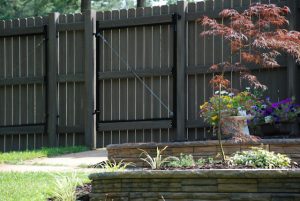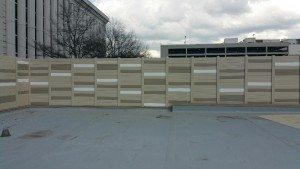The most common reason for building fences and other natural enclosures is to enclose houses and other buildings and in that way keep occupants, animals, and property safe and secure. Fencing can also be designed to provide privacy and to help control noise, wind, and even partially block out sunshine.
Fences may also be used to define outdoor spaces that are used for different activities, for instance:
- For recreation, entertaining, and relaxation,
- For utilities like washing lines or rubbish bins, and storage,
- To make a swimming pool area safe,
- To keep animals, especially dogs, in a contained space.
 Fences and various other natural enclosures may also be used as landscaping tools. They may be designed to support plants, used as a backdrop for shrubs and planted flowerbeds, and to provide shade for plants that don’t do well in full sun.
Fences and various other natural enclosures may also be used as landscaping tools. They may be designed to support plants, used as a backdrop for shrubs and planted flowerbeds, and to provide shade for plants that don’t do well in full sun.
But fences do not have to be strictly utilitarian. A carefully planned, imaginatively designed, and well-built fence can incorporate aesthetic characteristics and decorative qualities that will enhance your outdoor spaces.
If you’re stuck for ideas a good Georgia fence company will be able to help.
The Structural Design of Fences Can be Decorative
While there are a number of tried and tested designs that are popular for fences, a little creativity can be very effective, taking these a step further. For example, pickets of the quintessentially popular picket fence may have a shaped top and/or cutouts at the top to add interest. Alternatively just the tops of picket posts could be decorative, and teamed with square pickets.
The top of a simple saw-tooth board fence made with planks can be made more decorative by cutting points at the top, similar to the style used for many picket fences.
The supporting posts of metal fencing can be enhanced decoratively with domes, balls, and spears. These may also be used for all vertical poles or sections.
Using Color and Texture for Fences
 Color and texture, as well as pattern, are important elements in any type of design – interior, or exterior. Generally, light colored fences make a powerful backdrop for bold flowering plants and architectural species. Darker colors, including stained wood, make a great backdrop for light-colored foliage and flowers.
Color and texture, as well as pattern, are important elements in any type of design – interior, or exterior. Generally, light colored fences make a powerful backdrop for bold flowering plants and architectural species. Darker colors, including stained wood, make a great backdrop for light-colored foliage and flowers.
The type of fence you choose will determine the way it is built and the materials used. This, in turn, will determine how you can use texture to add interest. For instance, diagonal board fencing adds pattern and texture to the appearance of a fence, as does latticework. Adding lattice panels to the top of board fencing adds interest because of the texture and pattern the latticework introduces.
If you live in Georgia, Natural enclosures Fence Company can help plan, and then design and build a decorative fence for you that will also play an important functional role. Call us today to discuss what you want.
